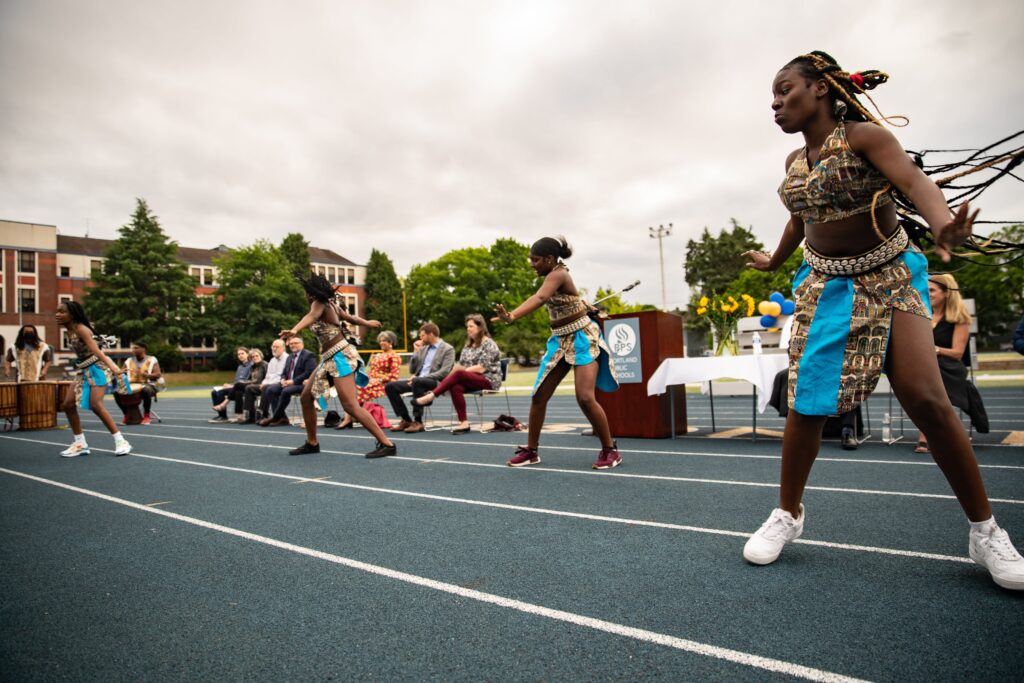Just 87 ninth graders will start high school at North Portland’s
Jefferson High School
next fall, as Portland Public Schools prepares to spend nearly
$500 million
to renovate the school, which sits at the center of the
historically Black Albina neighborhood
.
That mismatch is unsustainable, Superintendent Kimberlee Armstrong told the Portland school board Tuesday. Armstrong signalled that she plans to push hard for the board to sunset Jefferson’s unique “dual enrollment” zone, which since 2011 has given students who live within the school’s attendance boundaries the option to opt into either Grant, Roosevelt or McDaniel high school instead, depending on their address.
Ideally, the board will agree to shift enrollment boundaries for the incoming freshman class in fall of 2026 or 2027, Armstrong said, before construction is complete on the
new Jefferson building
, which is not slated to open until the fall of 2029.
“I think this is one of the biggest and hardest conversations,” Armstrong said. “Do we wait until the school is brand new and ready to open and risk Jefferson being 200 students or lower, or do we begin to make adjustments and shifts now?”
The full renovations, including to the school’s track and football field, are not scheduled to be complete until fall of 2030, though Armstrong told school board members Tuesday that she is actively seeking ways to accelerate the construction schedule on the
long-delayed modernization project
.
“We are calling on some additional resources to see how we might speed up the timeline and make some adjustments,” Armstrong said. “We know that for enrollment to thrive the way it needs to, the building needs to be modernized and open.”
Still, the timetable Armstrong floated is likely to face a tidal wave of pushback from families who would have to make the switch during the modernization process, instead of into a brand new school. It’s an especially perilous position for a district that has lost
11% of its enrollment
since 2019 and emphatically does not want to shed more students and the state funding that follows them.
Already, a budget question-and-answer document shows that only about 69% of high schoolers who live in the district choose to attend its high schools.
And the one-two punch of declining birth rates and high housing costs means that within 10 years, even Grant, now Portland’s largest high school with more than 2,200 students, is projected to have about 1,400 in its student body.
Another wrinkle to consider: Sunsetting dual enrollment could push more families to try for a lottery spot at
Benson High
, the most freshly and expensively renovated of the district’s high schools, school board member Julia Brim-Edwards pointed out Tuesday night. The career-technical magnet school, which draws students from around the district, is only a few miles from Jefferson and has space for 1,700 students, though its current enrollment is only about 1,000.
As of this school year, about 700 students who are eligible to attend Jefferson have chosen instead to go to Grant, while another 460 attend Roosevelt and about 200 go to McDaniel. Black students choose Jefferson at a higher rate than other schools, while white students are more likely to peel off to Grant, Roosevelt or McDaniel, said Renard Adams, Portland’s director of research, accountability and assessment.
All three of those schools are comprehensive neighborhood high schools that offer a wide variety of advanced courses, athletics and extracurricular opportunities. By contrast, Jefferson’s enrollment has hovered around 460 and, though it is known for its renowned dance program and personalized support for students, its small size makes it difficult to match the breadth of programming at other schools.
“We have to make changes that are going to rock the boat and are going to upset particularly white affluent parents, that are going to affect [their] children in ways they are not comfortable with,” school board member Christy Splitt said at Tuesday’s meeting. “This is equity. If you have a Black Lives Matter sign in your yard, you are going to have to make this switch with us.”
She suggested that the district should work with the Portland Association of Teachers on how to attract “excellent and experienced teachers to move to Jefferson and be part of this sea change.” But differentiated pay and similar incentives have traditionally been hard sells for labor unions.
The district will spend the next six months reaching out to families and gathering feedback about if and when to sunset the dual enrollment zone, Armstrong said Tuesday, with the goal of bringing a recommendation to school board members for a vote this coming winter.
Concurrently, the school district is launching a marketing campaign to persuade more families to enroll or return to the city’s public schools, which weathered an exodus of families to
home schooling and private schools
, particularly during the prolonged pandemic building closures.
Portland Public Schools has dipped its toes into marketing campaigns before, in winter 2024, when it ran a series of glossily curated social media ads extolling the virtues of Alameda Elementary School, Hosford Middle School and Lincoln High School, all in comparatively wealthy neighborhoods where private schools had made measurable inroads.
The new marketing campaign will be districtwide, Candice Grose, the district’s chief of communications, said Tuesday and will be multi-pronged, with “messaging and highlights from each school.” Plans are also in the works for focus groups with families who are unenrolling, especially at sixth grade, and targeted efforts for neighborhoods with particularly high student attrition.
That effort will run concurrently with what Armstrong has previously suggested will be a comprehensive look at whether some of the district’s 81 schools are candidates for closure or consolidation, though district officials prefer the more palatable euphemistic term “school optimization.”
Running an enrollment campaign while deciding whether or not to merge some schools will be a tricky balancing act, district officials acknowledged during budget hearings on Tuesday.
“When you increase the number of kids in a building, that leads to more funding and potentially more robust programming,” Chief of Schools Jon Franco said. “The disadvantage is of course the ripple effect in school communities.”
Twenty-one Portland Public elementary schools will have fewer than 300 students enrolled next year, according to current enrollment projections. By contrast, some elementary schools in suburban districts like Beaverton enroll up to
750 students
.
Atkinson Elementary parent Harmony Quiroz, who chairs Multnomah County’s Tax Supervising and Conservation Commission, the body charged with oversight of local government budgets, said her family has felt the see-saw impacts of an under-enrolled school.
“The programming goes up and down, the staffing goes up and down,” she said. “There’s the loss of experienced staff or having to rehire staff. Class size goes from 14 one year to 31 the next. There’s full time library, then there’s not a full time library. We’ve seen that our entire school experience.”
After school board members approved a budget with $42 million in cuts for the upcoming academic year and are braced for a potential $30 million more for 2026-2027, there’s practical value in considering the cost savings from paring back the number of schools, Franco said. He identified potential savings everywhere from utilities and custodial costs to transportation and reducing the district’s more than $1 billion deferred maintenance tab.
Historically, when the state’s largest school district has waded into
school closures
and attendance boundary redrawing
,
the effect has been akin to
whacking a hornets nest
. Its most recent effort to even out enrollments across 20 Southeast Portland schools, which mostly shifted students from lower-income schools but left close-in wealthier neighborhoods untouched, left a trail of bruised feelings.
Even several years later in Southeast Portland, though new school communities have bonded, some
resentment lingers
, particularly as the district evaluates drawing down the number of extra staff it had previously provided impacted schools as a way to offset the disruption.
Armstrong said it will be different this time. Portland is looking to communities that have more successfully navigated such conversations, like
San Antonio,
and also studying districts like
San Francisco
, where similar discussions infuriated the community, as a case study in what not to do. School closures are not a foregone conclusion for Portland, she said — the district could instead reconfigure program offerings and consider different attendance models.
“I’m feeling pretty confident that the way in which we do the work will be a model that can be used across the United States, because it will be done well, it will include different voices and the timeline will, I think, be fair,” Armstrong said Tuesday.
— Julia Silverman covers K-12 education for The Oregonian/OregonLive. Reach her via email at jsilverman@oregonian.com





More Stories
Portland Public Schools weighs big changes to school attendance maps
Portland Public Schools weighs big changes to school attendance maps
Portland Public Schools weighs big changes to school attendance maps